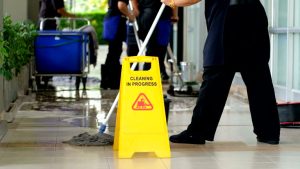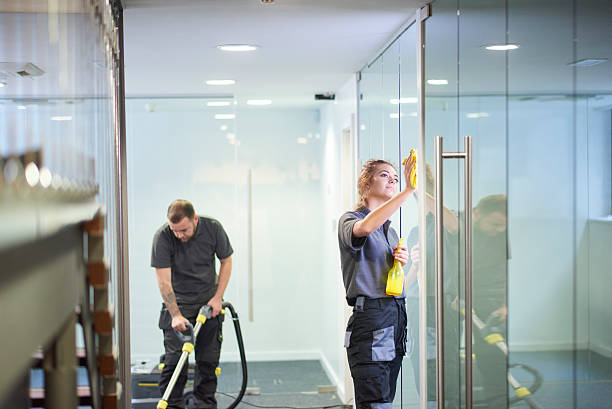Scrubbing away might feel satisfying, especially when cleaning commercial floors, but hold on a minute—do you know that over-wetting laminate floors can spell disaster? It’s like splashing water into a sandbox; nothing good comes out of it. Let’s chat about why you’re better off going easy with that mop.
Imagine you’ve got this gorgeous laminate flooring in your office. You want to keep it looking spanking new, right? But drenching the floor isn’t doing it any favors. Too much water seeps through the seams into the fiberboard beneath the laminate. Now, what happens there is the stuff of nightmares. The fiberboard starts to puff up like a marshmallow tossed into a campfire. The once-smooth surface becomes wavy, creating a modern art masterpiece—but not the kind you want on your floor.

You’re mopping like Cinderella, but instead of a ball, you end up with swollen and buckled floors. You must be thinking, “Can’t I just dry it up?” Not really. Once damaged, the internal structure is compromised, and there’s no coming back. Your only option might be to replace that part of the floor, which means more time, money, and elbow grease.
Let’s talk about the less-obvious pitfalls. When water seeps into the seams and joins, it doesn’t just evaporate. It hangs around, creating a snuggly environment for mold and mildew. Yuck, right? You’re thinking you’re killing two birds with one stone by cleaning and hydrating the floor, but mildew thinks it’s struck the lottery.
Visualize this: You walk into your office one morning and, instead of that fresh, clean smell, you’re greeted by a musty, damp odor. It’s like Mother Nature herself decided to pay an uninvited visit. Except, she brought some unwelcome friends like mold and mildew along for the ride. Trust me, that’s not the reception anyone’s hoping for.
Let’s not ignore those unsightly spots that start to form like someone sprinkled dark confetti. These are water stains. They tarnish your floor’s beauty, making it look older than it is. Think of it like rust on a shiny car. Sure, a little wear and tear is normal, but making it worse by over-wetting? That’s a hard ‘no.’
You might wonder if there’s a middle ground. Can you keep things clean without causing damage? Absolutely! Picture using a damp mop, not a drenched one. Or, hey, try a microfiber mop. These bad boys pick up dirt without needing buckets of water. They’re like the Swiss Army knives of cleaning tools—multi-functional and oh-so-efficient.
Cleaning floors isn’t exactly a thrilling Saturday night activity. And that’s probably why you’re tempted to soak the floor thinking it’s faster. It’s like cutting corners to win a race. You’ll end up spending more time fixing the damage than it would take to do the job right in the first place.
So, what’s the alternative? You’ve got options that won’t trash your floor. How about regular sweeping or vacuuming? Simply snagging a dustbuster on your way through the hallway can do wonders. Pair that with spot cleaning for spills—pop into action right when they happen, and you’re golden.
Unleash the Secrets to Banishing Tough Stains from Laminate Floors
Ah, laminate floors. The sleek, polished appearance adds a modern flair to any space, doesn’t it? Be it at home or for cleaning commercial floors, those pristine laminate surfaces suffice to elevate your aesthetic game. Until, that is, they encounter tough stains.
Imagine this: You’re sipping your morning coffee when BAM! You accidentally knock it over, and that dark liquid starts spreading across your beautiful laminate floor like an ink blotch on a white canvas. Panic ensues. But here’s the silver lining—you can banish those audacious stains with some simple yet effective tricks.
Now, let’s get into the specifics. Is it pet mess we’re dealing with? Those sneaky furballs can sometimes leave unpleasant surprises. Dampen a cloth with this concoction and gently dab the stain. Patience, my friend. It might take a few passes, but it’ll do the trick. Don’t drown your floor, though. Laminates and excess moisture? They’re not besties.
Next up, say you’ve got an oil-based stain—gravy, sauce, who knows? Cooking can be a battlefield. Flour, baby powder, or even baking soda can be your best buddy here. Follow up with a mild cleaner to finish the job.
Speaking of baking soda, if you’ve got stubborn marks (think markers, paint, or shoe scuffs), make a paste with baking soda and water. It’s like magic, but with science.
My laminate floor looked like a crime scene. Rushed into my pantry, grabbed white vinegar and made a quick-and-dirty solution: a cup of vinegar, a cup of warm water, and a couple of squirts of dish soap. Dampen a cloth with this mixture and go to town on the stain. Works like a charm! Plus, it leaves a pleasant zingy scent. Double win!
Now, let’s not forget your everyday hero—rubbing alcohol. A savior for ink stains and paint strokes. Moisten a cotton ball or cloth with it and gently blot the stain. It’s like the vanishing ink trick we adored as kids, but grown-up style.
Lastly, if you’re a fan of store-bought solutions, there are special laminate floor cleaners designed to tackle tough stains. They’re formulated to be gentle yet effective, kind of like a superhero in disguise.
Want to toss in a couple of pro tips? Always steer clear of abrasive tools or steel wool. They’ll scratch the living daylights out of your laminate. Also, a soft microfiber mop will be your sidekick in keeping the floor’s charm intact without causing harm.
Regular sweeping or vacuuming can prevent dirt and grit from morphing into stains. Sometimes it’s as simple as placing rugs in high-traffic areas or under dining tables. But hey, life happens. Stains are inevitable, but at least now you’ve got the know-how to tackle them head-on.
That, my friend, is your crash course in banishing those pesky stains from your laminate floors. Next time you face a spill, take a deep breath, and remember – you’ve got this. Your floors will be sparkling in no time, ready for life’s next mishap. Cheers!






